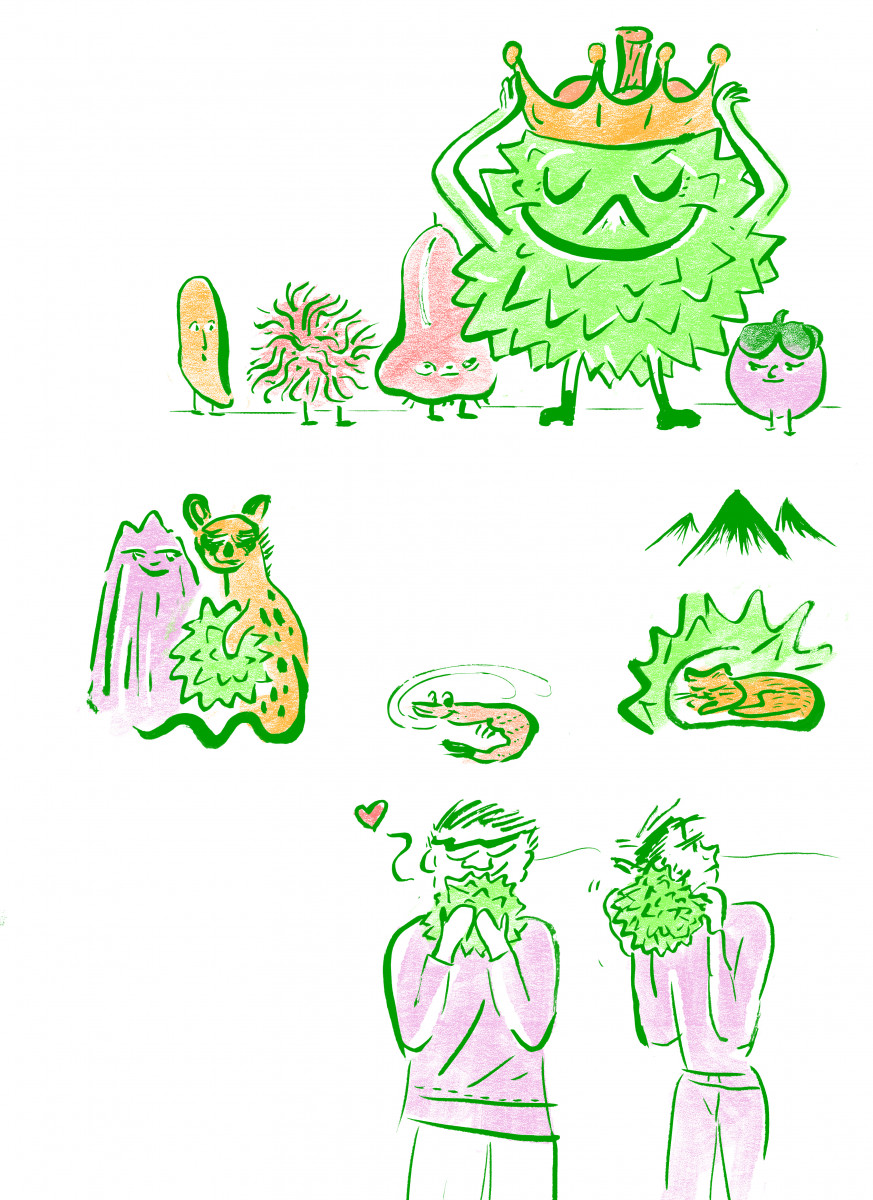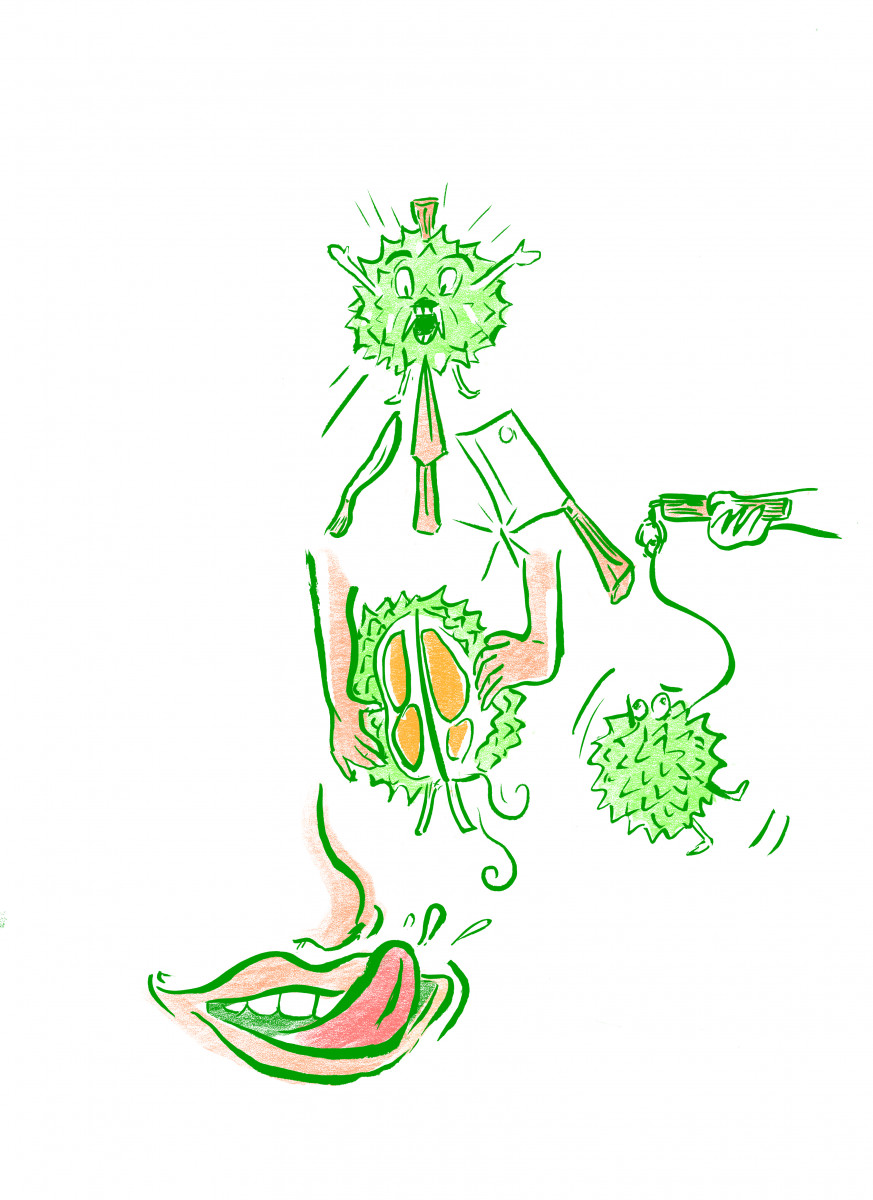
This is a durian, so named because of the “ouchy” spikes or “duri” all over its husk. Thorny on the outside and smelly on the inside, it is indeed baffling why this fruit is referred to as the “King of Fruits”.
Varieties
The fruit’s formidable thorn-covered rind can range from green to brown, and its delicious flesh can be white, pale yellow or even bright red, depending on the species. Popular varieties include some odd monikers such as Musang King (the name has nothing to do with the musang or civet cat but the place where it originated from: Gua Musang in Kelantan), Red Prawn, Kucing Tidur, D24 and Black Thorn, all bearing their own distinctive tastes.

How to choose
To select the “just-right” durian, first, smell it. A ripe durian must have a smell which is not overpowering.
Next, give it a good shake and listen out for dull, soft knocks of the seeds inside. No sound means still unripe while too noisy means overripe.

Aaah, that memorable pong fragrance!
The unmistakable and pervasive smell that emanates from durians has gotten it banned from public transportation, hotels and other public venues. Durians have twice caused evacuations in Australian universities due to fears that the fetid odour of the fruit was a gas-leak.
Never present an obstacle between a durian-lover and the majestic fruit.
If someone near you is enjoying a ripe and rank durian, do not call in a bomb squad. As the popular adage goes, “if you can’t beat them, join them”, so jump in and eat a piece too, and perhaps you won’t notice the stench as much. Else, simply move away to a safe distance upwind from the location.
Avoid wearing gas masks in front of or contemplating violent reprisals against durian addicts, perhaps using the aforementioned weapon — the murder melon — as durian advocates are large in numbers and a tad overzealous.
The late celebrity chef Anthony Bourdain, who enjoyed consuming the stinky fruit, said that eating durian makes the breath smell (and we paraphrase here) as if one has been in too close a proximity to one’s grandmother who had passed on. Another Anthony, novelist Anthony Burgess, writes that eating durian is “like eating sweet raspberry blancmange in the lavatory”.

The art of opening
Inside the shell are five sections with cavities that create swollen curves on the shell’s outer skin, indicating where the custardy fruit lies within. Each of the sections is divided by a soft pith, and the most common method of breaching the prickly fruit involves sticking a knife into the hull along one of these seams, and levering the soft white pith open to reveal the edible flesh within.
There are viral tales of people wholly unfamiliar with the durian who meticulously shaved all the thorns off, only to be faced with the perplexing sight of soft white rind instead of fleshy fruit.
In the past, a stake from the guava tree was said to be an effective tool in opening a durian due to the nature of its hard wood.
Today, you can still find blunt stakes of unspecified types of wood for sale as durian openers.
However, should you find the wooden stake an ineffectual tool for opening durians, you can always use it to execute vampires. As we were not presented with the opportunity to test both inferences, we can’t attest to its efficacy.
Many other gruesome implements have been invented to penetrate the shell of this sweet hedgehog. Some can be bought online but they may be a yea or nay depending on their efficacy and your needs.
What is ill-advised though is to try conquering this spiny sphere through dubious methods such as using your keys, reversing the back tyres of your jeep over it or thwacking it with a hammer.
If you have no tools at your disposal, one easy way to open this delicious but foul smelling fruit is by simply throwing it hard at the ground in a safe space, or by swinging it in a bag and slamming it onto the ground…
But beware, for now you’ve made a weapon called a murder melon, so do exercise the necessary precautions.

Other than au naturel
There are other ways to enjoy the spiky fruit. From ice-cream and cendol, to cakes and pastries, there are many sweet treats that utilise durians’ unique flavour to elevate its taste.
The seeds are edible too, once they have been cooked. They make yummy snacks after being boiled or roasted, or cut into thin slices and deep fried into crispy chips.
For those who prefer savoury dishes, try the fermented durian or tempoyak sambal, to be eaten with rice.
However, it would be prudent to avoid drinking alcoholic beverages when eating durian as there have been reports of individuals who have died after consuming wine with durian.
All good things in moderation
Enjoy your sweet malodorous treat, but do avoid excess indulgence.
Two segments of the flesh are equivalent to eating one ripe banana, while five segments are equivalent in calories to one bowl of rice. Over-indulging in 15 segments, for example, takes your calorie count to 625 kcal, equivalent to three bowls of rice. Unless you plan to skip some meals after your durian feast, enjoy it in moderation.

Ease the heat
Traditional belief claims that the durian has warming properties, sometimes called ”heatiness” and is liable to cause excessive sweating.
A practice said to balance out the heatiness is by drinking water from the empty husk after eating the creamy flesh within. Or counter the heatiness with the cooling properties of coconut water or mangosteens.
Deep cleanse
Rid the smell of the thorny fruit from your hands by pouring water into the empty husk and then using that water to wash your hands. You can even use it to gargle. Alternatively, simply use gloves to eat durians to save yourself from a whole lot of hassle.
Postscript
After you’ve had your durian fest, you may have some delectable morsels left over.
To prevent the other items in the fridge smelling like they have all gone bad, place the remaining segments of fruit in a sealed zipper bag, store in the freezer and hope for the best!
This story first appeared in Live! 2020 magazine. Download your copy of the magazine here.
TOP PICKS BY EDGEPROP

Baypoint @ Country Garden Danga Bay
Johor Bahru, Johor

Menara Bintang Goldhill
Bukit Bintang, Kuala Lumpur

Bandar Bukit Tinggi
Bandar Botanic/Bandar Bukit Tinggi, Selangor

Pangsapuri Akasia, Bandar Botanic
Bandar Botanic/Bandar Bukit Tinggi, Selangor

Pangsapuri Akasia, Bandar Botanic
Bandar Botanic/Bandar Bukit Tinggi, Selangor

Pangsapuri Akasia, Bandar Botanic
Bandar Botanic/Bandar Bukit Tinggi, Selangor

Menara HLX (formerly Menara HLA)
KL City Centre, Kuala Lumpur


















